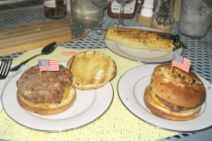Hamburger: Difference between revisions
imported>Hayford Peirce (put in revamped image instructions, now to create a template) |
mNo edit summary |
||
| (28 intermediate revisions by 7 users not shown) | |||
| Line 1: | Line 1: | ||
{{subpages}} | {{subpages}} | ||
{{TOC|right}} | |||
<onlyinclude> | |||
{{Image|4th of July Burger.jpg|left|212px|Barbecued hamburgers and corn on the 4th of July are a quintessentially American meal.}} | |||
[[ | A '''hamburger''' (or ''' hamburg''' or '''burger''' or '''hamburger sandwich''') is a [[sandwich]] made with a bun containing a patty of ground, cooked meat that is almost always beef, usually served with condiments such as relish, mustard, or ketchup. The bun is usually but not always toasted or otherwise warmed. | ||
Most authorities consider that the word "hamburger" is derived from the German city of Hamburg, which once enjoyed prosperous commerce with the Baltic Provinces in Russia, where shredded raw meat (we now know it as steak tartare) was popular. <ref>''The American Heritage Cookbook and Illustrated History of American Eating & Drinking'', Vol. 2, page 492</ref> Around 1900, a popular meal in the United States was "Salisbury steak," cooked, ground steak, which was promoted by a food faddist named Dr. J. H. Salisbury as a cure for innumerable ailments. At some point in the late 19th or early 20th century hamburgers as we know them, cooked patties within a roll, made their first appearance in the United States, although exactly where and when is still debated. | |||
Many cultures over the centuries have cooked finely chopped or ground meats in shapes such as meatballs, patties, or steaks, often flavored with other ingredients. The ''Larousse Gastronomique'', for instance, gives a half-dozen | Generally considered to be an informal meal or a convenience food, its meat can be grilled, fried, broiled, microwaved, or steamed. One of its most popular variations, a hamburger served with melted cheese on top, is called a cheeseburger. | ||
==Variations== | |||
Many cultures over the centuries have cooked finely chopped or ground meats in shapes such as meatballs, patties, or steaks, often flavored with other ingredients. The ''Larousse Gastronomique'', for instance, gives a half-dozen Hungarian, German, and Austrian recipes for what it calls ''Keftedes'', all translated as variations on "hamburgers". | |||
<ref>''Larousse Gastronomique'', first English edition, Paul Hamlyn, London, 1961, page 485</ref> | |||
Standardized or semi-standardized hamburgers are a major product of the [[fast food]] industry, produced by worldwide chains such as [[McDonald's]] and [[Burger King]]. | |||
</onlyinclude> | |||
==Health== | |||
Hamburgers vary in their fat content, depending on the amount of fat in the raw meat, and the means of cooking. A higher fat content is often believed to improve taste and make the cooked meat more juicy. Pan-frying will retain more fat than grilling or broiling over a grate. | |||
There have been serious food infection outbreaks due to ''[[Escherichia coli#Serotype O157|Escherichia coli,'' serotype O157]]. Thorough cooking of the meat reduces the chance of infection, although many prefer their hamburgers to have at least some redness in the center. | |||
==References== | ==References== | ||
<references/> | <references/> | ||
==See also== | |||
*[[American cuisine/Catalogs]][[Category:Suggestion Bot Tag]] | |||
Latest revision as of 11:00, 25 August 2024
A hamburger (or hamburg or burger or hamburger sandwich) is a sandwich made with a bun containing a patty of ground, cooked meat that is almost always beef, usually served with condiments such as relish, mustard, or ketchup. The bun is usually but not always toasted or otherwise warmed.
Most authorities consider that the word "hamburger" is derived from the German city of Hamburg, which once enjoyed prosperous commerce with the Baltic Provinces in Russia, where shredded raw meat (we now know it as steak tartare) was popular. [1] Around 1900, a popular meal in the United States was "Salisbury steak," cooked, ground steak, which was promoted by a food faddist named Dr. J. H. Salisbury as a cure for innumerable ailments. At some point in the late 19th or early 20th century hamburgers as we know them, cooked patties within a roll, made their first appearance in the United States, although exactly where and when is still debated.
Generally considered to be an informal meal or a convenience food, its meat can be grilled, fried, broiled, microwaved, or steamed. One of its most popular variations, a hamburger served with melted cheese on top, is called a cheeseburger.
Variations
Many cultures over the centuries have cooked finely chopped or ground meats in shapes such as meatballs, patties, or steaks, often flavored with other ingredients. The Larousse Gastronomique, for instance, gives a half-dozen Hungarian, German, and Austrian recipes for what it calls Keftedes, all translated as variations on "hamburgers". [2]
Standardized or semi-standardized hamburgers are a major product of the fast food industry, produced by worldwide chains such as McDonald's and Burger King.
Health
Hamburgers vary in their fat content, depending on the amount of fat in the raw meat, and the means of cooking. A higher fat content is often believed to improve taste and make the cooked meat more juicy. Pan-frying will retain more fat than grilling or broiling over a grate.
There have been serious food infection outbreaks due to Escherichia coli, serotype O157. Thorough cooking of the meat reduces the chance of infection, although many prefer their hamburgers to have at least some redness in the center.
